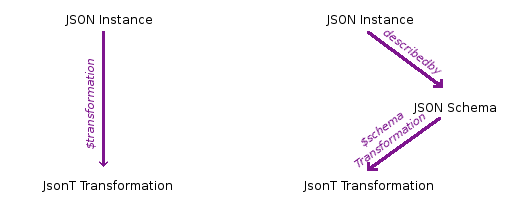jsonGRDDL
Buzzword.org.uk Draft 3 September 2010
- This version:
- http://buzzword.org.uk/2008/jsonGRDDL/spec.20100903
- Latest version:
- http://buzzword.org.uk/2008/jsonGRDDL/spec
- Previous version:
- http://buzzword.org.uk/2008/jsonGRDDL/spec.20090903
- Editor:
- Toby Inkster
Copyright © 2008–10 Toby Inkster, some rights reserved.
Abstract #
| GRDDL | uses XSLT | linked to from namespace documents | (or from XML files directly) | to transform XML | into RDF/XML. |
| jsonGRDDL | uses JsonT | linked to from JSON Schemas | (or from JSON files directly) | to transform JSON | into RDF/JSON. |
JSON is an increasingly popular format to return results from RESTful web services. Although many websites provide JSON APIs to access their data, clients wishing to make use of this data need to be custom written for each API, as the data structures differ from site to site.
RDF/JSON takes advantage of RDF concepts to provide a single data format capable of storing virtually any data. However, many JSON APIs simply return a structure closely resembling the application's internal representation of the data — probably a format quite different to RDF/JSON. What is desired is a mechanism to translate arbitrary JSON data into RDF/JSON, so that developers can apply the rich set of RDF tools (triple stores, query engines, etc) to JSON data.
JSON is often seen as an alternative to XML, and many XML technologies have been ported to JSON, such as SOAP and Schemas. Thus a natural way to map JSON to RDF would be to port GRDDL to JSON. The jsonGRDDL draft specification attempts to do just that.
Status of this Document #
This document is a draft, but already fairly stable. There are
no features considered to be "at risk". Future drafts may add
additional methods to the global JSON object mentioned
in chapter 1, and/or add more global objects which may be used,
such as an XmlHttpRequest-like object. Some parts of
this draft rely on JSON Schema, which is still a draft itself and
subject to change. Future versions may allow HTTP Link
headers that contain a fragment identifier in the anchor
parameter, and provide guidance on how to resolve that fragment
identifier to an object nested inside the JSON data.
Please send feedback to the editor or the JSON schema Google Group.

